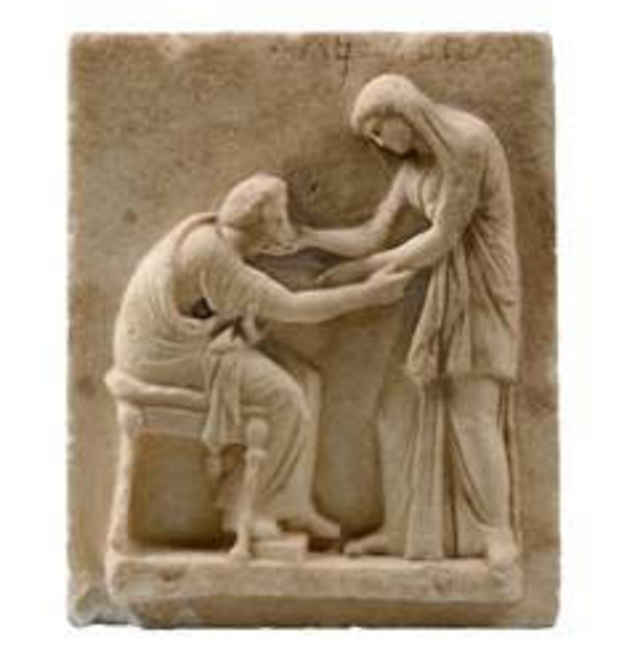“A World Full of Emotions: Ancient Greece, 700 BC – 200 AD” Exhibition
Onassis Cultural Center NY

This event has ended.
Bringing to vivid life the emotions of the people of ancient Greece, and prompting questions about how we express, control, manipulate, or simulate feelings in our own society, the Onassis Cultural Center New York will present the path-breaking exhibition A World Full of Emotions: Ancient Greece, 700 BC – 200 AD.
On view exclusively at the Onassis Cultural Center New York, where admission is always free, the exhibition brings together more than 130 masterpieces from leading museums including the Acropolis Museum, the National Archaeological Museum, Athens, the Louvre, the British Museum, and the Vatican Museums to explore the ideas and attitudes of people in classical antiquity toward emotion and the ways in which the emotions were depicted, revealing how some are strikingly familiar to us and some shockingly alien. Although ancient Greece is often said to have been flooded with the light of reason, A World Full of Emotions lays bare the far different reality addressed in the Iliad, whose very first word is menis: wrath.
Developed by a team of guest curators over the course of more than four years, A World Full of Emotions will feature vase paintings, sculptures (ranging from life-size statues from the Acropolis to relief carvings from cemeteries), theatrical masks, amulets, coins, and votive offerings, among other artifacts from the early 8th century BC (the traditional date of the Iliad) to the late 2nd century AD. Many will be on view in the United States for the first time, and some will be seen for the first time outside Greece. Together, these objects provide a timely opportunity to think about the role of feelings in our own personal, social, and political lives, while helping to advance the relatively new field of the history of emotions.
Amalia Cosmetatou, Executive Director and Cultural Director of the Onassis Foundation USA, said, “Thanks to the brilliant work of our guest curators A World Full of Emotions will make an important new contribution to scholarship, while bringing the public into the presence of objects that still have the power to move and astonish more than 2,000 years after they were made.”
Theoretical writings about the emotions date back to ancient Greece itself. Only within the past few decades, however, have scholars begun to investigate emotional life as a force that shapes societies, influences historical processes, and varies in different contexts—giving rise, for example, to such unique characteristics of ancient Greece as the belief that figures such as Eros (love) and Phobos (fear) were not just representations of emotions but actual gods to be supplicated or placated. These investigations face an inherent challenge, however, since the principal medium for research—textual evidence—is often a thin source, composed to filter, disguise, or even mute emotions as much as to reveal or arouse them. A World Full of Emotions expands the possibilities of a history of emotions in classical antiquity by going beyond literary texts and inscriptions to include the evidence of the visual arts.
The distinguished historian Angelos Chaniotis, co-curator of the exhibition, said, “We cannot directly study neurobiological processes in ancient Greece. But we can see how social norms, religious beliefs, philosophical ideas, and education determined the manifestations of emotions, and how emotions in turn determined social interaction, political behavior, and religious practice. This is our gain from studying emotions in the Greek world. What we learn about emotions in one culture and one historical period helps us understand another. It sharpens our mind to reflect on our lives and our world.”
A World Full of Emotions: Ancient Greece, 700 BC – 200 AD is curated for the Onassis Cultural Center New York by Angelos Chaniotis, Professor of Ancient History and Classics, Institute for Advanced Study, Princeton; Nikolaos Kaltsas, Director Emeritus, National Archaeological Museum, Athens; and Ioannis Mylonopoulos, Associate Professor of Ancient Greek Art and Archaeology, Columbia University. The exhibition will be accompanied by a catalogue and a schedule of exhibition tours and public programs, some of them held off-site in collaboration with BAM and LIVE from the NYPL. There will also be Family Sundays at the Onassis Cultural Center New York monthly. More information will be announced in the coming months.
Lenders to the exhibition, in addition to those cited, include the National Archaeological Museum, Athens; Museum of the Ancient Agora, Athens; Kerameikos Archaeological Museum, Athens; Numismatic Museum, Athens; Ephorate of East Attica; Brauron Archaeological Museum; Delos Archaeological Museum; Heraklion Archaeological Museum; Ioannina Archaeological Museum; Marathon Archaeological Museum; Museum of Cycladic Art, Athens; Pella Archaeological Museum; Piraeus Archaeological Museum; Archaeological Museum of Pythagoreion, Samos; Archaeological Museum of Vathy, Samos; Thebes Archaeological Museum; Thera Archaeological Museum; Thessaloniki Archaeological Museum; Veroia Archaeological Museum; The George Tzolozidis Collection, Thessaloniki; Diachronic Museum, Larissa; Museo Archeologico Nazionale, Naples; Musei Capitolini, Centrale Montemartini, Rome; Metropolitan Museum of Art, New York; Museum of Fine Arts, Boston; Staatliche Antikensammlungen und Glyptothek, Munich; and Antikenmuseum und Sammlung Ludwig, Basel.
Media
Schedule
from March 09, 2017 to June 24, 2017